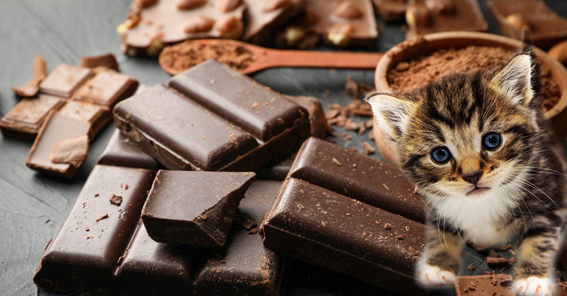THE DANGER HIDDEN IN THE CHOCOLATE. A POISON FOR OUR FRIENDS
- Details
- Category: Diet
- Hits: 113

Some foods that we eat cannot be assimilated by our friends and are very dangerous or lethal for them. Among these we find garlic, alcohol, avocado, chocolate, egg (raw) and grapes. In this article we will talk about chocolate.
This delicacy for us is instead a poison for our felines because it contains some substances, including theobromine which stimulates the nervous system. Felines metabolize it much more slowly than humans and it remains in circulation in the body for longer and causing damage to many organs, the main one being the central nervous system and then the circulation, breathing and urinary tract. The lethal dose in cats is around 80-200 mg per kilo of body weight, but it is very dangerous even in small doses. Usually and fortunately the cat does not like the taste of chocolate and therefore in most cases does not get to eat a dose that puts his life in danger. But let's be extremely careful because there is always the exception.
The percentages of theobromine vary greatly depending on whether it is dark chocolate and pure cocoa or milk or white chocolate. In dark chocolate and pure cocoa the concentration is much higher. Even a small but repeated dose of chocolate is very dangerous, because theobromine accumulates in the body.
Symptoms of chocolate poisoning are:
- Arrhythmia and Tachycardia
- Increased thirst
- Cramps
- Diarrhea
- Hyperactivity
- Restlessness
- Vomit
They appear between two and twenty-four hours after ingesting the chocolate and can remain for several days.
If we suspect that our 4-legged friend has eaten chocolate, finding the chocolate wrapper chewed, chocolate scattered, or the cat showing the symptoms indicated above, we must urgently take our cat to the vet.
The diagnosis is not easy to make because the symptoms are common to many other pathologies.
Only the veterinarian will have to evaluate how to intervene on a case-by-case basis.
Treatment for our little feline is based on relieving symptoms and supporting bodily functions.
The first hours after taking the chocolate, the veterinarian can try to induce vomiting and administer activated charcoal to prevent theobromine from being absorbed into the blood.
If the cat survives the acute stage of envenomation, it usually makes a full recovery. And we will control the little one so that he no longer reaches the chocolate and other substances or foods that are toxic and poisonous to him.
